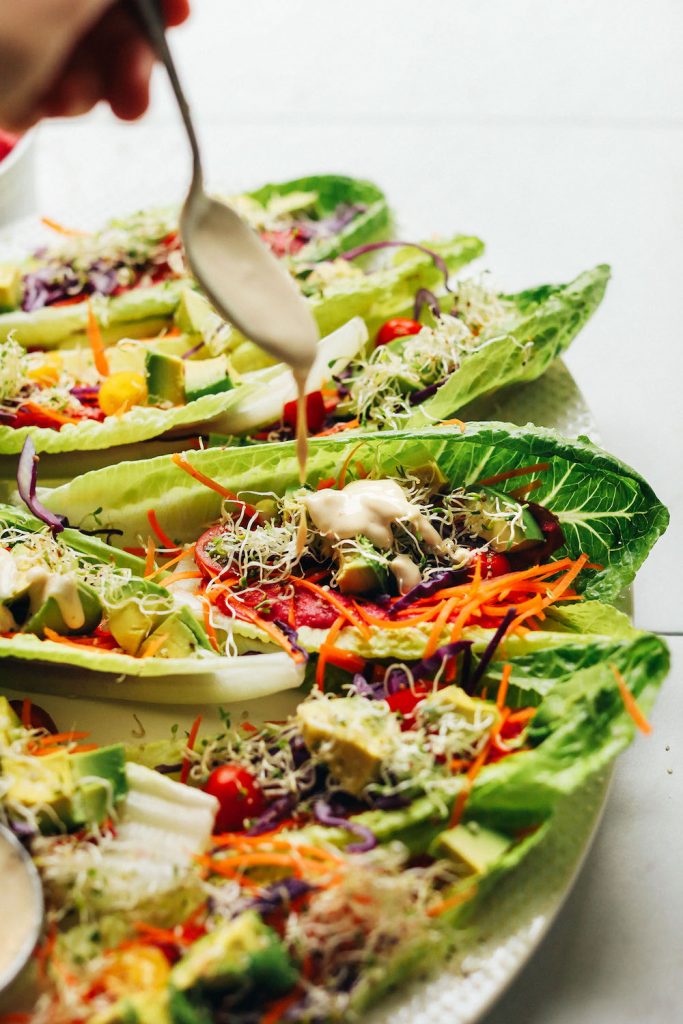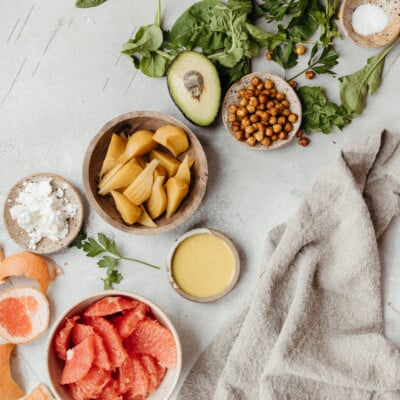Looking for a diet revamp in 2022? One that doesn’t involve counting calories or super strict rules? Look no further than the flexitarian diet—otherwise known as eating “mostly plants” according to Michael Pollan. As we enter the new year, there’s never been a better season to focus on vegetables. It’s an opportune time to give flexitarian-ism a try. With this approach, the point isn’t to swear off meat—particularly if you enjoy eating animal protein. After all, high-quality meat is full of health benefits. Rather, a flexitarian approach is about building a plate that shifts the ratio from mostly animals to mostly plants. In turn, creating delicious (and nutritious!) meals. Let’s dig in.

What Does Flexitarian Mean?
As a flexitarian, you eat a mostly vegetarian diet. Occasionally, you eat meat. Simply put, it’s a semi-vegetarian lifestyle. By definition, the flexitarian diet is a combination of the words “flexible” and “vegetarian.” It’s a cross between being a full-fledged vegan and eating animal products every so often. This approach to eating—also known as a flexitarian diet—strikes a balance between flavor and pleasure, and nutrition and sustainability.
What Is the Flexitarian Diet?
Like the Mediterranean diet, the flexitarian diet is less of a diet and more of a lifestyle. In essence, the flexitarian diet is synonymous with ‘flexible vegetarianism.’ A majority of the time, you load up on fruits, veggies, legumes, grains, plant-based sources of protein, etc.
Flexitarian is a marriage of two words: flexible and vegetarian. The term was coined more than a decade ago by Registered dietitian Dawn Jackson Blatner in her 2009 book, The Flexitarian Diet: The Mostly Vegetarian Way to Lose Weight, Be Healthier, Prevent Disease and Add Years to Your Life. Through a flexitarian approach, she encourages minimizing meat without excluding it altogether. It’s an inclusive eating plan. Meaning, it’s less about taking away foods and more about adding to the foods you already eat. It gradually guides you to eat more veggies while still enjoying your favorite meats.
How Does the Flexitarian Diet Work?
As the name implies, it’s all about flexibility. You have a range of options: Flexible meal plans, meat-substitute recipes, and more. Plus it’s a helpful way to introduce vegetarianism into a family’s current lifestyle. In essence, this semi-vegetarian diet focuses on healthy plant proteins and other whole, minimally processed plant-based foods. It encourages meat and animal products, but in moderation. But, what does this imply? Depending on your commitment level to the flexitarian diet, you could be consuming 9-28 ounces of meat per week. Ultimately, that’s the beauty of this way of eating, you can choose how much to cut down. And, you can do it gradually.
How to Eat Less Meat
If you’re overwhelmed by cutting down your meat consumption, don’t fret. Eating less meat is akin to gradually cutting back on caffeine. To start, forgo meat two days per week. In the beginning, aim for no more than 3-ounces (about a card-deck-sized portion) of meat during mealtimes. One month later, focus on following a full vegetarian diet three to four days per week. Limit meat consumption to 18-ounces of meat during the other days. Eventually, follow a vegetarian diet for at least five days per week. When you do eat meat, try to limit it to under 10 ounces. Furthermore, when you do eat meat, aim for quality over quantity. If possible, choose organic, pasture-raised, grass-fed, and/or wild-caught animal protein.
Health Benefits of the Flexitarian Diet
You might be wondering—is the flexitarian diet a healthy option to consider? The short answer: Yes. According to Dawn Jackson Blatner, flexitarians weigh 15% less, have a lower rate of heart disease, diabetes, and cancer, and live 3.6 years longer than their carnivorous counterparts. According to Cleveland Clinic, other benefits include improved heart health, weight loss, decreased risk of type 2 diabetes, and environmental stewardship.
The flexitarian diet is also easy to follow, can help you save money, and can aid in satiation (from eating more nuts, seeds, and healthy fats). At any rate, it emphasizes prioritizing and eating produce. In turn, this will likely cut down on your consumption of salt and sugar-laden processed and packaged foods.
Disadvantages of the Flexitarian Diet
While the cons are few, you may feel deprived on the flexitarian diet. In essence, like all diets, eating this way has the potential to feel restrictive. However, this really depends on your why behind taking a flexitarian approach and your overall relationship with food. Secondly, you may feel tempted to fill up on processed foods. Rather than replace meat with junk and processed options, keep healthy snacks on hand: Raw walnuts, fresh fruit, meal prepped veggies and hummus, hard-boiled eggs, etc. Lastly, be mindful of your B12 and iron levels. Both of these are essential for energy and are abundant in animal protein. As a reminder, consult your healthcare physician before making changes to your diet.
Foods to Eat As a Flexitarian
Aim to eat the least processed, most natural form of foods. Don’t worry about counting calories! IF you’re eating plant-based foods that come from the earth, you’re getting fiber and a variety of micro and macronutrients. This style of eating is meant to be inclusive, so here’s what to add to your grocery list:
- Fruits
- Vegetables
- Plant proteins (beans such as black, kidney or navy, edamame, chickpeas, lentils, tofu)
- Whole grains (brown rice, oats, barley, and quinoa)
- Plant-based milk (although dairy milk is fine in moderation)
- Eggs
- Dairy (cheese, yogurt, or dairy alternatives)
- Meat and seafood, in moderation
Tips Before Starting the Flexitarian Diet
Before getting started, skim through this checklist:
- Fuel up on whole foods. Eat plenty of healthy whole foods, like legumes and beans, nuts and seeds, whole grains, and eggs (if you’re flexi-vegetarian). These contain protein and complex carbs, helping you feel satiated. Don’t forget healthy fats, like coconut oil and avocado.
- Opt for high quality meat. To help you get your B12 and iron levels, consider red meat, like lamb and beef or fatty fish (salmon) and shellfish. When you do eat meat or animal, try to make it intentional.
- Start slow. You can ease into the flexitarian diet and define your own version of it. Furthermore, try new recipes! Michael Pollan’s book, Mostly Plants is a resourceful, delicious place to start.
7-Day Flexitarian Meal Plan
Wholesome, delectable—and mostly plants—we put together a delicious flexitarian meal plan. These recipes are packed with nourishing foods, made with fridge and pantry staples. Happy eating!
Monday
- Superfood Porridge (sweet or savory!) by Camille Styles.
- Banh Mi Sandwich by Love & Lemons.
- Chickpea Caesar Salad by Minimalist Baker.
Tuesday
- Root Vegetable Hash Egg Skillet by Naturally Ella
- Leftover Chickpea Caesar Salad
- Roasted Veggie Glow Bowls by Dishing Out Health
Wednesday
- Green Protein Power Breakfast Smoothie by I love Vegan
- Leftover Roasted Veggie Glow Bowls
- Ultimate Veggie Pizza by Cookie + Kate
Thursday
- Protein Chia Pudding Cups by Fit Foodie Finds
- Lentil Salad by Feel Good Foodie
- Sweet Potato & Black Bean Chili by Camille Styles
Friday
- Tofu Scramble by Nora Cooks
- Leftover Lentil Salad
- Black Bean Tacos With Mango Salsa by Camille Styles
Saturday
- Hummus Avocado Toast by Eating Bird Food
- Leftover Sweet Potato & Black Bean Chili
- Tempeh Lettuce Wraps by Healthy Nibbles
Sunday
- Morning Glory Muffins by The Natural Nurturer
- Lentil Burgers by Cooking For Peanuts
- Ginger Miso Soba Soup by Fork Knife Swoon
Will you give the flexitarian diet a try?











